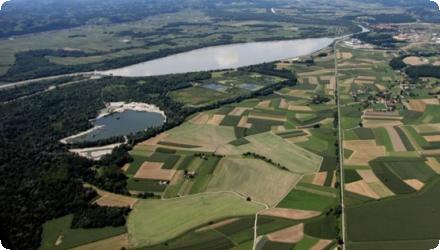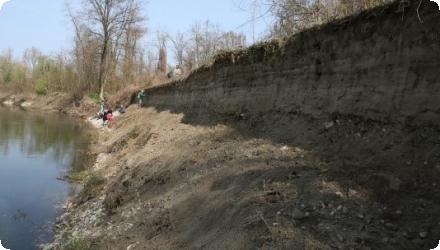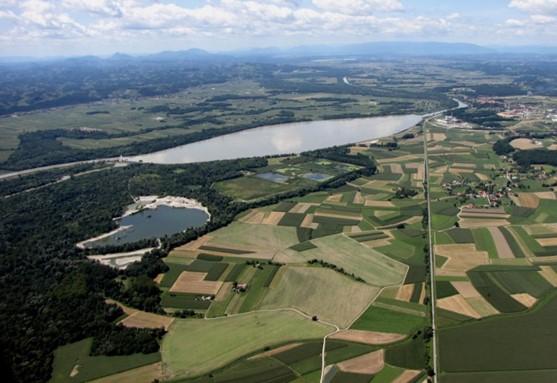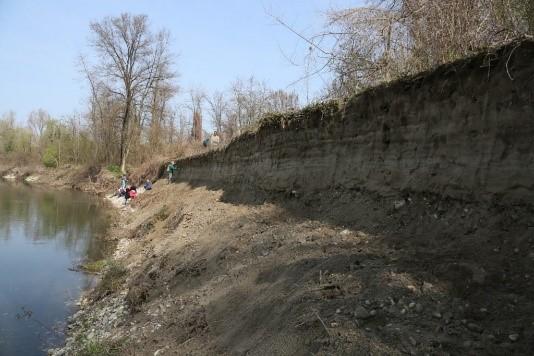Last update
2025
Summary
Although the natural dynamics of the Drava River were heavily altered by three hydro-power plants, key lowland river features remain: side channels, dry grasslands within flooded forest, gravel bars, diverse banks and artificial water bodies such as reservoirs. These habitats, together with the restored abandoned wastewater basins of the former Ormož sugar factory, now form one of Slovenia’s most important wetlands for migrating waterbirds. Under the LIFE+ LiveDrava project (2012-2017), three side channels were reconnected, breeding islands and nesting banks created, and semi-natural wetlands established with constant water supply. Monitoring recorded 29 fish species, increased populations of target birds (e.g. +25 % Kingfisher, +200 % Sand Martin) and the first national record of a Natura 2000 fish species. The Ormož Basins Nature Reserve was officially designated in 2017, later expanded to about 66 ha, and is managed by DOPPS with measures such as water buffalo grazing. The site is part of the transboundary Mura-Drava-Danube UNESCO Biosphere Reserve since 2021, and plays a growing role in biodiversity conservation, education and eco-tourism.
Position
Latitude
46.391819
Longitude
16.172257
Project
NWRM
National Id
Slovenia-05
Installation date
2012
Contact
Damijan DENAC, director DOPPS
RBD code
SI_RBD_1
Transboundary
0
Photo gallery
Location of the project
Alluvial plain called “Dravska ravan” in NE Slovenia between Maribor and Središče ob Dravi, encompassing Lake Ptuj and Ormož Basin Nature Reserve., SI
NUTS Code
SI01 - Vzhodna Slovenija
Project's objectives
Reconnect three side channels.
Create/restore 2–3 breeding islands and artificial nesting banks for target bird species.
Increase breeding populations of Sand Martin and Kingfisher by at least 20 % over baseline.
Achieve stable or increasing trends for selected fish species, with at least 25 species recorded post-restoration.
Create/restore 2–3 breeding islands and artificial nesting banks for target bird species.
Increase breeding populations of Sand Martin and Kingfisher by at least 20 % over baseline.
Achieve stable or increasing trends for selected fish species, with at least 25 species recorded post-restoration.
Involved Partners
| Authority type | Authority name | Role | Comments |
|---|---|---|---|
Climate zone
cool temperate moist
Temperature
10.5°C
Annual rainfall range
900 - 1200 mm
Elevation range
184
Slope range
1-2%
Groundwater level
~3.67 m below surface on 8 Aug 2025.
Vegetation class
Predominantly wetland reedbeds and wet grasslands, with adjacent riparian forest patches; also seasonally flooded meadows and gravel bars.
Water bodies: Ecological Status
Moderate
Water bodies: Chemical Status
Failing to achieve good
Water quality status
Hydromorphological alteration and flow regulation, sediment accumulation management on the Drava
Project scale
Meso
Project scale specification
The project covers a stretch of the lower Drava River between Maribor and Središče ob Dravi, including multiple restored side channels, floodplain habitats, and the Ormož Basins Nature Reserve (~66 ha). It operates at the river reach / sub-basin level, with interventions along several kilometres of the Drava and in connected wetlands, rather than at a single point site or across the whole national basin.
Lifespan
10 years
Total cost
€ 4.098.910
Costs total information
1,3 million for personnel, 1 million for assistance, 1 million for infrastructure, 270.000 for equipment, 91.000 for consumables.
Financing authorities
Type of funding
EU-funds: LIFE+
Comments
2.033.455 €
Compensations
0
Land ownership
The Ormož Basins Nature Reserve area was donated in 2010 to DOPPS – BirdLife Slovenia by the former sugar factory owner (TSO d.d.) for conservation purposes.
Community involvment
No
Design consultation activity
| Activity stage | Name | Key issues | Comments |
|---|
Policy target
| Target purpose |
|---|
Policy pressure
| Pressure directive | Relevant pressure |
|---|
Policy impact
| Impact directive | Relevant impact |
|---|
Requirement directive
| Requirement directive | Specification |
|---|
Contractual arrangements
0
| Arrangement type | Responsibility | Role | Name | Comments |
|---|
Part of wider plan
0
Wider plan type
| Wider plan type | Wider plan focus | Name | Comments |
|---|
DOPPS conducts ongoing biodiversity monitoring to track target species and habitat conditions in line with Natura 2000 objectives.
Complete monitoring was established in the very beginning for all target species, to be able to quantify the conservation effects.
Different types of bird indicators/specific monitoring were carried out in the project. Monitoring of waterbirds at Lake Ptuj and Lake Ormož was carried out by regular total counts during entire project period in 10-day intervals. Monitoring of all qualifying species for SPA Drava at Ormož Basins NR was carried out using mapping method annually between 2013-2017. Monitoring of the breeding numbers of Common Tern and Black-headed Gull was carried out during two visits (first in April - gulls, second in May - terns) in the managed breeding colonies every year. Monitoring of breeding riverbed birds was done using rubber boat without use of engine. Two to three counts were carried out every year in the riverbed of Drava River between Maribor and Zavrč. For this purpose entire section was divided into 3 sectors. Upon our request Slovenian Environment Agency (ARSO) issued us a permission (no. 35601-53/2013 – 4, dated 18th Apr 2013) for the performance of ecological study on Little Ringed Plover. In the study, capture-recapture, colour ringing and placing of geolocators was done. Field work was carried out between early April and early August in years 2014, 2015, 2016. In total, 177 nests were found (most in early stage of incubation or during egg-laying) and their fate followed in 4-day intervals until hatching or failure. Beetle monitoring revealed that all together more than 170 beetle taxa were recorded in the area, among them 87 saproxylic. Besides Cucujus cinnaberinus, six additional important nature-conservation species were found in the dry part of the Ormož Basins Nature Reserve. One specie was recorded for the first time for Slovene beetle fauna - Acupalpus interstitialis.
After the abolition of illegal hunting at Lake Ormož, the populations of overwintering waterbirds significantly recovered. In the autumns and winters (Sep-Jan) of 2012/2013-2014/2015, only 2,300-4,300 waterbirds were recorded on the lake on average, whereas in the first season after the hunting abolition (2015/2016), this number rose to 7 300 waterbirds, with the highest numbers in November even exceeding 10,000 individuals.
As a result of island’s management, 118 pairs of Common Tern bred at Lake Ptuj in 2017, which is the largest number in the last 14 years. Black-headed Gull increased even more. In 2017 its population at SPA Drava was 853 breeding pairs – all at the Lake Ptuj on the managed island. Manual creation of breeding walls at the riverbanks significantly helped populations of Sand Martin and Kingfisher. With this management together with side arms restorations 5 new breeding pairs (BP) of Kingfisher was established which is increase of SPA population by 25%. Besides Kingfisher, Sand Martin benefited from the management, too. Efforts yielded an average of 574 BP of Sand Martins (in the 2013-2017 period), which is a threefold increase of the SPA population compared to the long-term average of 194 pairs in the 2000-2012 period.
Removal of woody vegetation from overgrown gravel bars resulted in an average 17 (35%) more breeding pairs of Little Ringed Plover and 6 (15%) of Common Sandpiper. Disturbances like illegal driving at the gravel bars were prevented at 7 sites. Ditches and road barriers were used and informative boards always placed to explain the meaning of the action. That way the disturbances were reduced for the first time ever on the SPA Drava and resulted in 4 (8%) new BP of Little Ringed Plover and 1 (2.5%) of Common Sandpiper.
In Ormož Basin Nature Reserve, during the spring migration, Wood Sandpiper and Ruff were again present after several years of non-appearance, indicating the area started functioning as the stopover site for shorebirds again. Breeding of Ferruginous duck, Garganey and Shoveler is expected in the future. Little Grebe, Marsh Harrier, Water Rail, Spotted Crake, Moorhen, Coot, Lapwing and Little Ringed Plover were already confirmed as breeders. White-tailed Eagle is regularly present at the area. Occurrence of all species is a direct result of the restoration. Water beetles were not directly targeted species for the basins, however monitoring revealed that the basins became the most important site for water beetles in Slovenia, holding at the moment largest number of endangered species! In restored river branch, species Graphoderus billineatus was not confirmed yet, but for the first time in the area the plant species Water Violet Hottonia palustris was found, which is promising for the beetle as it is ecologically connected to this plant species. Quantitative data for the saproxylic beetles cannot be evaluated yet, but both species Hermit beetle (Osmoderma eremita) and Cucujus cinnaberinus were found at the project area.
Fish monitoring revealed that the ecological conditions for the fish species improved after the carried out restoration of the three river branches. The Bitterling population became more stable and less vulnerable. The preservation of cut-off channels, side arms and deep sections of the Drava is crucial for the successful conservation of Bitterlings, Spined Loach and Asp. Sampling proved the presence of the majority of expected species, but for the first time at Drava River the Golden Spined Loach (Sabanejewia balcanica) was found. It is listed among Anex II species of Habitat Directive.
The results of the socio-economic study indicate an increase in the social acceptance of project activities, which confirms that communication and educational activities have had a positive effect in the adoption of NATURA 2000 area as an opportunity zone, and was not perceived as an obstacle. The results of all included target groups showed an increased awareness of the term Natura 2000 and an increased knowledge regarding the protected areas. A socio-economic study made at the beginning and at the end of the project proved that the project significantly improved the public's knowledge of the Natura 2000 network, LIVEDRAVA project, Ormož Basins as an important bird area and DOPPS, as well as support to the Ormož Basins NR.
Different types of bird indicators/specific monitoring were carried out in the project. Monitoring of waterbirds at Lake Ptuj and Lake Ormož was carried out by regular total counts during entire project period in 10-day intervals. Monitoring of all qualifying species for SPA Drava at Ormož Basins NR was carried out using mapping method annually between 2013-2017. Monitoring of the breeding numbers of Common Tern and Black-headed Gull was carried out during two visits (first in April - gulls, second in May - terns) in the managed breeding colonies every year. Monitoring of breeding riverbed birds was done using rubber boat without use of engine. Two to three counts were carried out every year in the riverbed of Drava River between Maribor and Zavrč. For this purpose entire section was divided into 3 sectors. Upon our request Slovenian Environment Agency (ARSO) issued us a permission (no. 35601-53/2013 – 4, dated 18th Apr 2013) for the performance of ecological study on Little Ringed Plover. In the study, capture-recapture, colour ringing and placing of geolocators was done. Field work was carried out between early April and early August in years 2014, 2015, 2016. In total, 177 nests were found (most in early stage of incubation or during egg-laying) and their fate followed in 4-day intervals until hatching or failure. Beetle monitoring revealed that all together more than 170 beetle taxa were recorded in the area, among them 87 saproxylic. Besides Cucujus cinnaberinus, six additional important nature-conservation species were found in the dry part of the Ormož Basins Nature Reserve. One specie was recorded for the first time for Slovene beetle fauna - Acupalpus interstitialis.
After the abolition of illegal hunting at Lake Ormož, the populations of overwintering waterbirds significantly recovered. In the autumns and winters (Sep-Jan) of 2012/2013-2014/2015, only 2,300-4,300 waterbirds were recorded on the lake on average, whereas in the first season after the hunting abolition (2015/2016), this number rose to 7 300 waterbirds, with the highest numbers in November even exceeding 10,000 individuals.
As a result of island’s management, 118 pairs of Common Tern bred at Lake Ptuj in 2017, which is the largest number in the last 14 years. Black-headed Gull increased even more. In 2017 its population at SPA Drava was 853 breeding pairs – all at the Lake Ptuj on the managed island. Manual creation of breeding walls at the riverbanks significantly helped populations of Sand Martin and Kingfisher. With this management together with side arms restorations 5 new breeding pairs (BP) of Kingfisher was established which is increase of SPA population by 25%. Besides Kingfisher, Sand Martin benefited from the management, too. Efforts yielded an average of 574 BP of Sand Martins (in the 2013-2017 period), which is a threefold increase of the SPA population compared to the long-term average of 194 pairs in the 2000-2012 period.
Removal of woody vegetation from overgrown gravel bars resulted in an average 17 (35%) more breeding pairs of Little Ringed Plover and 6 (15%) of Common Sandpiper. Disturbances like illegal driving at the gravel bars were prevented at 7 sites. Ditches and road barriers were used and informative boards always placed to explain the meaning of the action. That way the disturbances were reduced for the first time ever on the SPA Drava and resulted in 4 (8%) new BP of Little Ringed Plover and 1 (2.5%) of Common Sandpiper.
In Ormož Basin Nature Reserve, during the spring migration, Wood Sandpiper and Ruff were again present after several years of non-appearance, indicating the area started functioning as the stopover site for shorebirds again. Breeding of Ferruginous duck, Garganey and Shoveler is expected in the future. Little Grebe, Marsh Harrier, Water Rail, Spotted Crake, Moorhen, Coot, Lapwing and Little Ringed Plover were already confirmed as breeders. White-tailed Eagle is regularly present at the area. Occurrence of all species is a direct result of the restoration. Water beetles were not directly targeted species for the basins, however monitoring revealed that the basins became the most important site for water beetles in Slovenia, holding at the moment largest number of endangered species! In restored river branch, species Graphoderus billineatus was not confirmed yet, but for the first time in the area the plant species Water Violet Hottonia palustris was found, which is promising for the beetle as it is ecologically connected to this plant species. Quantitative data for the saproxylic beetles cannot be evaluated yet, but both species Hermit beetle (Osmoderma eremita) and Cucujus cinnaberinus were found at the project area.
Fish monitoring revealed that the ecological conditions for the fish species improved after the carried out restoration of the three river branches. The Bitterling population became more stable and less vulnerable. The preservation of cut-off channels, side arms and deep sections of the Drava is crucial for the successful conservation of Bitterlings, Spined Loach and Asp. Sampling proved the presence of the majority of expected species, but for the first time at Drava River the Golden Spined Loach (Sabanejewia balcanica) was found. It is listed among Anex II species of Habitat Directive.
The results of the socio-economic study indicate an increase in the social acceptance of project activities, which confirms that communication and educational activities have had a positive effect in the adoption of NATURA 2000 area as an opportunity zone, and was not perceived as an obstacle. The results of all included target groups showed an increased awareness of the term Natura 2000 and an increased knowledge regarding the protected areas. A socio-economic study made at the beginning and at the end of the project proved that the project significantly improved the public's knowledge of the Natura 2000 network, LIVEDRAVA project, Ormož Basins as an important bird area and DOPPS, as well as support to the Ormož Basins NR.
Maintenance
DOPPS maintains the reserve through water management, invasive plant removal, grazing by water buffalo, and upkeep of nesting habitats.
Edge of Field/Plot
Land value and image: Positive change in the perception of the site—from disused industrial basins to a nationally important wetland—has enhanced the area’s environmental profile and attractiveness for soft tourism. Increased regional visibility through inclusion in the transboundary Mura-Drava-Danube UNES
Local employment and skills: URBACT (2025) reports job creation linked to reserve management, guided tours, and maintenance work.CO Biosphere Reserve in 2021.
Eco-tourism development: The creation of the Ormož Basins Nature Reserve has attracted visitors for birdwatching and nature walks. Installation of an educational trail (~1.5 km) and observation points has increased public access and tourism potential.
Local employment and skills: URBACT (2025) reports job creation linked to reserve management, guided tours, and maintenance work.CO Biosphere Reserve in 2021.
Eco-tourism development: The creation of the Ormož Basins Nature Reserve has attracted visitors for birdwatching and nature walks. Installation of an educational trail (~1.5 km) and observation points has increased public access and tourism potential.
Information on retained water
Side-channel reconnection: Three side channels of the Drava were reconnected, restoring flow and hydraulic diversity.
Wetland creation: Abandoned wastewater basins at Ormož converted into semi-natural wetlands with constant water supply, increasing local water retention capacity.
Wetland creation: Abandoned wastewater basins at Ormož converted into semi-natural wetlands with constant water supply, increasing local water retention capacity.
Information on Water quality overall improvements
Pollution source removal: Former industrial basins no longer receive sugar factory wastewater; now function as clean wetland habitat.
1
Fish: 29 fish species recorded post-restoration (target: ≥25 spp.), including the first Slovenian record of a Natura 2000 fish species (species not named in public summary).
Birds:
Kingfisher population ↑ +25 % (5 more breeding pairs).
Sand Martin population ↑ +200 %.
Increased numbers of breeding Common Tern and Black-headed Gull on Ptuj Lake island.
Significant increases in wintering waterbirds (peak >10,000 individuals in Nov 2015–2016).
Plants & invertebrates: Discovery of Hottonia palustris and certain rare beetles for the first time in the region.
Birds:
Kingfisher population ↑ +25 % (5 more breeding pairs).
Sand Martin population ↑ +200 %.
Increased numbers of breeding Common Tern and Black-headed Gull on Ptuj Lake island.
Significant increases in wintering waterbirds (peak >10,000 individuals in Nov 2015–2016).
Plants & invertebrates: Discovery of Hottonia palustris and certain rare beetles for the first time in the region.
Key lessons
Riparian ecosystems of the Drava River have been degraded in the past, with populations of qualifying Natura 2000 species decreasing or disappearing. DOPPS has been active in the area since its establishment in 1979, addressing threats and problems at the heart of the LiveDrava project. Restoration works showed that even in a river system altered by hydropower, targeted hydromorphological interventions such as side-channel reconnection and wetland creation can quickly improve habitat quality and attract key species, exceeding several biodiversity targets. The formal designation and later expansion of the Ormož Basins Nature Reserve, coupled with active management measures like water buffalo grazing, proved essential for maintaining these gains over time. Community engagement, educational activities, and eco-tourism development strengthened local support for conservation, demonstrating that protecting riparian habitats can deliver both ecological and socio-economic benefits. The project also highlighted the importance of recognising and sustaining the ecosystem services provided free of charge by healthy floodplain systems. Although Project LiveDrava has ended, conservation work and efforts for public welfare along the Drava River continue.
Success factor(s)
| Success factor type | Success factor role | Comments | Order |
|---|---|---|---|
|
Financing possibilities
|
main factor
|
LIFE Project |
Driver
| Driver type | Driver role | Comments | Order |
|---|
Transferability
Many such areas exist along most of EU rivers and could deserve similar management approach to increase local diversity, especially of endangered species.
Guidelines for sustainable water management of Drava River were presented and available to relevant expert audience, and we strongly believe they will serve as model for similar initiatives in Slovenia and throughout the EU. Therefore, we argue that strong added value of the entire project is corroborated through high replication potential of these Guidelines and their orientation towards the implementation of EU policies. Achievement of policy uptake were presented in details at the LIFE conference in Zagreb on 2nd Feb 2018 organized by Ministry of Environment and energy of Croatia under LIFE14 CAP/HR/14 project.
Guidelines for sustainable water management of Drava River were presented and available to relevant expert audience, and we strongly believe they will serve as model for similar initiatives in Slovenia and throughout the EU. Therefore, we argue that strong added value of the entire project is corroborated through high replication potential of these Guidelines and their orientation towards the implementation of EU policies. Achievement of policy uptake were presented in details at the LIFE conference in Zagreb on 2nd Feb 2018 organized by Ministry of Environment and energy of Croatia under LIFE14 CAP/HR/14 project.
English



